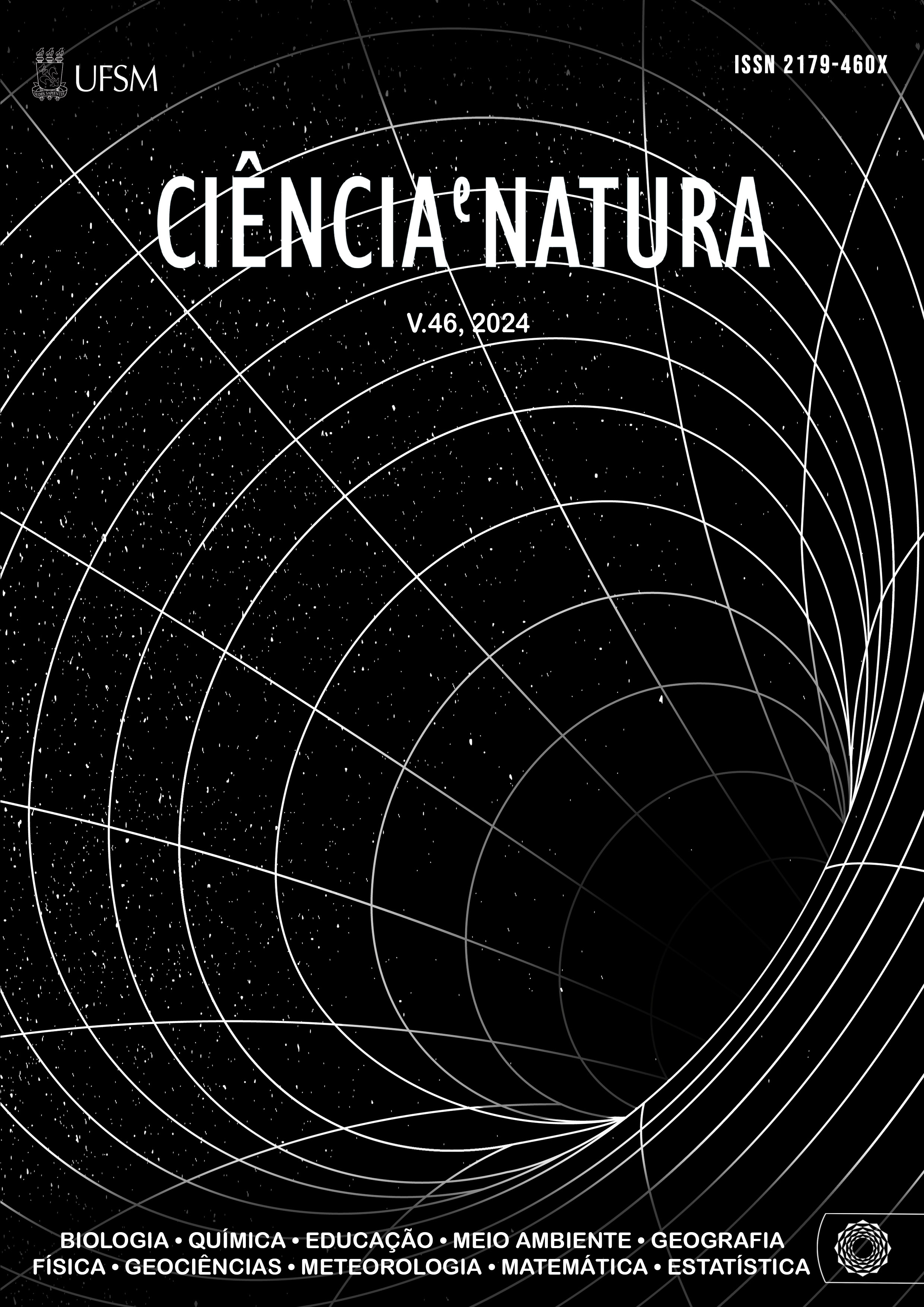Analysis of circadian rhythm synchronization under the influence of pain
DOI:
https://doi.org/10.5902/2179460X73631Keywords:
Synchronization, Biological rhythms, Pain, PIM modelAbstract
The synchronization of biological rhythms is of fundamental importance for health. The influence of pain on the functioning of vital functions and its effects on the synchronization of biological rhythms in human beings have been explored clinically for a long time. On the other hand, the modeling of this phenomenon can add features that are still unexplored. This bias fits the present contribution: to analyze the existence of synchronization of the circadian rhythm under the influence of external factors such as pain. To that end, we propose and investigate a model of coupled and phase oscillators that describes the sleep-wake, body temperature, and pain rhythms. The simplicity of the modeling allows one to obtain the synchronized solutions analytically as well as derive restrictions in terms of the parameters that guarantee their synchronization. The results obtained by analyzing the proposed model are accompanied by numerical simulations.
Downloads
References
Bard, E.; Youngmin, P.; Dan, W.; (2019). Recent advances in coupled oscillator theory. Phil. Trans. R. Soc. A., 337, 2160, 1 – 16. https://doi.org/10.1098/rsta.2019.0092. DOI: https://doi.org/10.1098/rsta.2019.0092
Bick, C.; Goodfellow, M.; Laing, C. R.; Martens, E. A.; (2020). Understanding the dynamics of biological and neural oscillator networks through mean-field reductions: a review. J. Math. Neurosc. 10, 9. https://doi.org/10.1186/s13408-020-00086-9. DOI: https://doi.org/10.1186/s13408-020-00086-9
Bumgarner, J. R., Walker, W. H., Nelson, R. J. (2021). Circadian rhythms and pain. Neuroscience Biobehavioral Reviews, 129, 296–306. doi: 10.1016/j.neubiorev.2021.08.004. DOI: https://doi.org/10.1016/j.neubiorev.2021.08.004
Cai, Z.; Zheng, Z.; Xu, C.; (2022). Exact dynamics of phase transitions in oscillator populations with nonlinear coupling.
Communications in Nonlinear Science and Numerical Simulation, V. 107, P. 106–129. DOI: https://doi.org/10.1016/j.cnsns.2021.106129. DOI: https://doi.org/10.1016/j.cnsns.2021.106129
Contessa, M. N.; De Cezaro, A.; (2017). Derivadas fracionárias na modelagem do ritmo circadiano. Scientia Plena, 13, 4, 1–11. https://doi.org/10.14808/sci.plena.2017.049909. DOI: https://doi.org/10.14808/sci.plena.2017.049909
Dörfler, F.; Bullo, F.; (2014). Synchronization in complex networks of phase oscillators: A survey. Automatica, 50, 6, 1539–1556. DOI: https://doi.org/10.1016/j.automatica.2014.04.012. DOI: https://doi.org/10.1016/j.automatica.2014.04.012
Glaeser, S. S.; Santos, A. T.; De Cezaro, A.; Machado, C. M. d. S., Adamatti, D. F.; (2018). Modeling of circadian rhythm under influence of pain: an approach based on multi-agent simulation. ADCAIJ: Advances in Distributed Computing and Artificial Intelligence Journal, 7, 2, 17–25. DOI: https://doi.org/10.14201/ADCAIJ2018721725
Glaeser, S. S.; De Cezaro, F.; De Cezaro, A.; (2023). Synchronization of the circadian rhythms with memory: A simple fractional- order dynamical model based on two coupled oscillators. Trends in Comput Appl Mathematics, 24, 2, 1–15. DOI: https://doi.org/10.5540/tcam.2023.024.02.00245. DOI: https://doi.org/10.5540/tcam.2023.024.02.00245
Journal of Biological Rhythms, 22, 2, 91–102. DOI: https://doi.org/10.1177/0748730407299200.
Klerman, E. B.; Hilaire, M. S.; (2007). On mathematical modeling of circadian rhythms, performance, and alertness. DOI: https://doi.org/10.1177/0748730407299200
Kuramoto, Y.; (1984). Chemical Oscillations, Waves, and Turbulence. Vol. 19, Springer, Berlin, https://doi.org/10.1007/978-3-642-69689-3. DOI: https://doi.org/10.1007/978-3-642-69689-3
Neves, A. R.; Albuquerque, T.; Quintela, T.; Costa, D.; (2022). Circadian rhythm and disease: Relationship, new insights, and future perspectives. Journal of Cellular Physiology, 237, 8, 3239–3256. DOI: https://doi.org/10.1002/jcp.30815. DOI: https://doi.org/10.1002/jcp.30815
Palada, V.; Gilron, I.; Canlon, B.; Svensson, C. I.; Kalso, E.; (2020). The circadian clock at the intercept of sleep and pain. PAIN, 161, 5, 894–900. DOI: 10.1097/j.pain.0000000000001786. DOI: https://doi.org/10.1097/j.pain.0000000000001786
Pikovisky A, K. J.; Rosemblum M.; (2001). Synchronization: A Universal Concept in Nonlinear Sciences, 1º edn. Cambridge University Press. ISBN: 052153352X. DOI: https://doi.org/10.1017/CBO9780511755743
Rodrigues, F. A.; Peron, T. K. D.; Ji, P.; Kurths, J.; (2016). The kuramoto model in complex networks. Physics Reports, 610, 26, 1 – 98. https://doi.org/10.1016/j.physrep.2015.10.008. DOI: https://doi.org/10.1016/j.physrep.2015.10.008
Downloads
Published
How to Cite
Issue
Section
License
Copyright (c) 2024 Ciência e Natura

This work is licensed under a Creative Commons Attribution-NonCommercial-ShareAlike 4.0 International License.
To access the DECLARATION AND TRANSFER OF COPYRIGHT AUTHOR’S DECLARATION AND COPYRIGHT LICENSE click here.
Ethical Guidelines for Journal Publication
The Ciência e Natura journal is committed to ensuring ethics in publication and quality of articles.
Conformance to standards of ethical behavior is therefore expected of all parties involved: Authors, Editors, Reviewers, and the Publisher.
In particular,
Authors: Authors should present an objective discussion of the significance of research work as well as sufficient detail and references to permit others to replicate the experiments. Fraudulent or knowingly inaccurate statements constitute unethical behavior and are unacceptable. Review Articles should also be objective, comprehensive, and accurate accounts of the state of the art. The Authors should ensure that their work is entirely original works, and if the work and/or words of others have been used, this has been appropriately acknowledged. Plagiarism in all its forms constitutes unethical publishing behavior and is unacceptable. Submitting the same manuscript to more than one journal concurrently constitutes unethical publishing behavior and is unacceptable. Authors should not submit articles describing essentially the same research to more than one journal. The corresponding Author should ensure that there is a full consensus of all Co-authors in approving the final version of the paper and its submission for publication.
Editors: Editors should evaluate manuscripts exclusively on the basis of their academic merit. An Editor must not use unpublished information in the editor's own research without the express written consent of the Author. Editors should take reasonable responsive measures when ethical complaints have been presented concerning a submitted manuscript or published paper.
Reviewers: Any manuscripts received for review must be treated as confidential documents. Privileged information or ideas obtained through peer review must be kept confidential and not used for personal advantage. Reviewers should be conducted objectively, and observations should be formulated clearly with supporting arguments, so that Authors can use them for improving the paper. Any selected Reviewer who feels unqualified to review the research reported in a manuscript or knows that its prompt review will be impossible should notify the Editor and excuse himself from the review process. Reviewers should not consider manuscripts in which they have conflicts of interest resulting from competitive, collaborative, or other relationships or connections with any of the authors, companies, or institutions connected to the papers.






